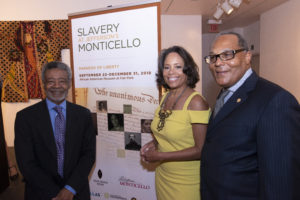
By Becky Mayad
A groundbreaking and widely acclaimed exhibition with a powerful message, Slavery at Jefferson’s Monticello: Paradox of Liberty is now open at the African American Museum in Fair Park (3536 Grand Ave. in Dallas) and continues through Dec. 31.
Dallas is the first city to host the updated traveling exhibition, which brings to life the story of slavery at Monticello through more than 300 objects, works of art, documents and artifacts unearthed at the storied plantation. The exhibition features new items never seen outside of Monticello, including a special feature on Sally Hemings, one of the most famous African American women in American history. As an enslaved woman at the age of 16, Hemings negotiated with one of the most powerful men in the nation ensuring she would receive “extraordinary privileges” and achieve freedom for her children. Jefferson fathered at least six children with Hemings, four of whom survived to adulthood.
“America’s history is complex and often contradictory,” said Bishop T.D. Jakes, senior pastor of The Potter’s House of Dallas and honorary chair of the exhibition. “Slavery at Jefferson’s Monticello: Paradox of Liberty explores how the author of the Declaration of Independence, who introduced a fledgling nation to the concept that all men are created equal, could own slaves while 20 percent of Americans were also held in chains and designated 3/5 human. How do we view such contradictory posturing through a 21st century lens? I urge people of all ages and ethnic backgrounds to come and discover the other side of American History.”
Slavery at Jefferson’s Monticello: Paradox of Liberty is organized by the Thomas Jefferson Foundation at Monticello and the African American Museum, Dallas, in partnership with the National Endowment for the Humanities and in cooperation with the City of Dallas Office of Cultural Affairs and VisitDallas. Dallas City Councilmember Kevin Felder spearheaded the effort to bring the exhibition to Dallas.
“Our sweeping American story, wonderful and woeful as it is, leaves out too many people whose contributions have been ignored or denied. This exhibit returns those forgotten men, women and children to the American narrative, restoring to them not only their place in history, but also their very humanity,” said Gayle Jessup White, Monticello’s community engagement officer and a Hemings family and Jefferson descendant.
The expanded exhibition builds upon the momentum of a major new exhibition that Monticello unveiled earlier this summer in Charlottesville, Va. In conjunction with national Juneteenth events, Monticello debuted exhibitions and newly restored spaces, including the opening of the South Wing and The Life of Sally Hemings exhibit. This landmark conclusion of a major restoration initiative at Monticello also commemorates 25 years of the Getting Word Oral History Project. Monticello welcomed the largest reunion of descendants of Monticello’s enslaved families in modern history and hosted a rare copy of the Emancipation Proclamation generously loaned by David M. Rubenstein.
“This exhibition delivers a powerful message, one that has the potential to educate, inspire and promote greater understanding, which is something we now need more than ever,” said Councilmember Felder, who played a key role in bringing the exhibition to Dallas. “We’re so very pleased to bring this to the people of Dallas, Texas and the Southwest.”
Slavery at Jefferson’s Monticello: Paradox of Liberty is an exhibition that uses Monticello, the home and plantation of Thomas Jefferson, to explore the dilemma of slavery and the lives of the enslaved families and their descendants. The exhibition presents Monticello as a microcosm of the American story — a lens through which to understand the complicated dynamics of America’s founding, and the ways in which the legacies of slavery continue to shape the nation.
Thomas Jefferson’s iconic words in the Declaration of Independence — “all men are created equal” — inaugurated a new nation defined by principles of freedom and self-government, while a fifth of the population remained enslaved. Jefferson called slavery “an abominable crime,” yet he owned 607 people over the course of his lifetime. This exhibition uses the power of place and ideas at Monticello to grapple with the paradox of slavery in an age of liberty. Most notably, Slavery at Jefferson’s Monticello brings individuals and families out of the shadows of chattel slavery, pulling from more than 50 years of archaeology, documentary research and oral histories to fill in the critical human dimension missing from many resources on slavery in the United States. Through the exhibition, visitors “meet” members of six families who lived and labored at Monticello, as well as their descendants. Their family stories form a narrative arc from slavery to freedom that reflects the trajectory of the nation at large — an ongoing journey to realize the foundational promise that “all men are created equal.”
Paradox of Liberty briefly examines Jefferson’s views, actions and inaction on slavery, and then focuses on the enslaved individuals and families who lived and labored at Monticello. In addition to objects belonging to Jefferson, more than 300 archaeologically recovered artifacts elucidate the lives and work of six enslaved families, making for a visually rich, powerful presentation. Using material from the Getting Word Oral History Project, the exhibition follows the families through Emancipation into the present.
“The popular story, however, is usually told from Jefferson’s perspective. The objective of this exhibition is a bit different — to convey her life through her eyes. We want visitors to understand Sally Hemings as a person through her family roles as a mother, daughter and sister,” added Jessup White. “The goal is for visitors — actual and virtual — to understand her struggle and the struggle of all enslaved people, intellectually and viscerally. While we will reference and summarize her link with Jefferson and its 200-plus-year controversy, the main story is Sally Hemings and her children.”
